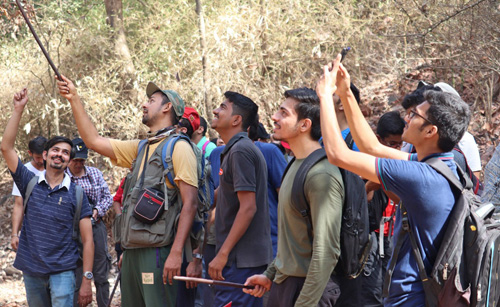- Indian Jezebal
Scientific name: Delias eucharis
The Common Jezebel is a medium sized p  ierid butterfly found in many areas of South and Southeast Asia, especially in the non-arid regions of India, Sri Lanka, Myanmar and Thailand. The Common Jezebel is one of the most common species in the genus Delias (Indo-Austrailian).
ierid butterfly found in many areas of South and Southeast Asia, especially in the non-arid regions of India, Sri Lanka, Myanmar and Thailand. The Common Jezebel is one of the most common species in the genus Delias (Indo-Austrailian).
Its under hind-wings are yellow with black veins and a row of marginal triangular red spots.
Its upper front is white with black veins featuring the Jezebal butterfly.
It is a slow, restless flier but can fly high in tree canopy though often will descend to low-growing flowers.
They pretend to be dead when handled. It has a bright coloration to indicate the fact that it is unpalatable due to toxins accumulated by the larvae from the host-plants. It is not palatable to birds.
Before pupation, their larvae wander long distance and pupate. The pupae is golden yellow with black markings.
It is commonly seen in gardens. It rests with its wings closed exhibiting the brilliantly coloured underside.
The Jezebel often flies high up in the canopy and usually comes lower down only to feed on nectar in flowers.
2. Common Emigrant
Scientific name: Catopsilia pomona
Also called as “lemon emigrant”, as upper-side is greenish ‘white or yellow’.
The common emigrant is a medium-sized pierid butterfly found in Asia, Cambodia and parts of Australia.
 During pre-monsoon and monsoon months, some areas experience emergence of a large number of these butterflies which then migrate to other areas. Hence the English name “Emigrant”.
During pre-monsoon and monsoon months, some areas experience emergence of a large number of these butterflies which then migrate to other areas. Hence the English name “Emigrant”.
This had become very common due to natural presence as well as plantation of its host plants, the cassia species along the road sides.
It is a fast flier, covering long distances high above the ground in straight, powerful, long, up-and-down curved flight. It is found in wet places of Western Ghats.
3. Blue Mormon
Scientific name: Papilio polymnestor
The Blue Mormon is a large swallowtail butterfly & the “state butterfly” of the Indian state of Maharashtra. With a wingspan of 120–150 mm, it is the fourth largest butterfly of India. This family of butterflies include the largest butterflies in the world, the birdwing butterflies.
Tailless, it’s upper front is dark blue to black with upper hind is pale blue with two rows of large black spots. Its upper front has red marking at the base.

It has a strong, dipping flight, flashing it’s pale blue colours. They prefer moist, dense forests at lower elevations. This butterfly frequents forest paths and streams. Seen on wet mud, flowers, etc. Attracted to damp patches , but also visits animal droppings.
Occasionally seen in urban areas also, due to host plant Lime plantations.
The male is fond of sun and avoids the shade.
It has larger larvae which when touched, it projects pink osmeteria (defensive organ) with strong pungent smell.
4. Blue Oakleaf
Scientific name: Kallima horsfieldii
This butterfly is found in India in the Western Ghats from Mumbai southwards; Sri Lanka; Burma.
It’s upper side is bluish green, Under-side spots and blotches mimic patches of fungus and mould found on dead leaves. Its a perfect camouflage of a dry leaf and is impossible to detect.
 It has a fast, erratic flight to escape predators or will spend most of their time on a tree trunk or bush with head pointing downwards and fly only if disturbed. When the clever camouflage artist decides to spread its wings to bask in the sunlight, or when it takes flight, we finally get a glimpse of the vibrant blue colour that lends the butterfly part of its name.
It has a fast, erratic flight to escape predators or will spend most of their time on a tree trunk or bush with head pointing downwards and fly only if disturbed. When the clever camouflage artist decides to spread its wings to bask in the sunlight, or when it takes flight, we finally get a glimpse of the vibrant blue colour that lends the butterfly part of its name.
It visits flowers, damp patches, but is fond of oozing tree sap and juices extruding from ripe fruits.
It flies inside the dense jungle in the day but keeps out of the sun.
5. Plum Judy
Scientific name: Abisara echerius
The Plum Judy or Dancing Judy, is a small, tailless, rusty-brown shade loving butterfly which is more active during late afternoon and evening in the open. It flies up and down paths with fast jerky flight. It flies short distances and lands on upper surface of leaves with half open wings, which never close and are held parallel to each other. It does a dance like movement on a leaf while feeding or shifting position. It repeats this turning movements as it moves along branches.
 This butterfly is found mainly in southern eastern ghats. This active butterfly is usually seen at the tops of trees and amidst foliage. It is mostly distributed in the low land and subtropical forests. It prefers moist dense forests.
This butterfly is found mainly in southern eastern ghats. This active butterfly is usually seen at the tops of trees and amidst foliage. It is mostly distributed in the low land and subtropical forests. It prefers moist dense forests.
It is a shade loving insect, venturing out rarely during the late afternoon or early evening. The male perches on leaves among forest paths during early morning hours.
It has a habit of landing and turning around almost immediately after alighting. It repeats this turning movements as it moves along branches. This is believed to help in evading predators by causing confusion about head orientation. This distinctive mode of movement gives the impression of dancing and is an important field characteristic that helps in identifying the species from even a distance.
6. Painted Lady
Scientific name: Vanessa cardui
It is one of the most widely distributed butterflies in the world. It is found every where except the Arctic and Antarctic regions. It flies great distances at a considerable height during migration.
They largely breed in higher elevations. Compared to other butterfly species, spotting Painted Lady is not easy as they fly high and move faster.
 Painted Lady is considered as one of the most adaptable butterflies as it has more than 300 host plants.
Painted Lady is considered as one of the most adaptable butterflies as it has more than 300 host plants.
It’s upper-side is orange-yellow with broad black apex and rows of black spots.
It is a fast active flier. It darts rapidly up and down glades and open forest paths at forest edges, frequently settling flaps (it’s wings) in a slow rhythmic manner. It often takes off suddenly to land at some distance but never stays at one place for long. It comes to flowers, rotten fruits and damp patches. The Male is territorial and has affinity to human sweat.
7. Red Pierrot
Scientific name: Talicada nyseus
The red Pierrot, is a small but striking butterfly found in the Indian subcontinent and South-East Asia.
It is a white butterfly with broad orange marginal band bearing white spots under-side of wings while on upper-side is black with a broad orange area at hind wings.
The Red Pierrot is a weak flier, and flutters about close to the ground. Usually seen in gardens on low plants not far from the food plant. After settling on flowers, it rubs it’s hind wings.
 It visits flowers of herbs, especially of the families Amaranthaceae and Acanthaceae, for nectar. It visits both ornamental and wild flowers and varieties of Alternanthera are among its favourites.
It visits flowers of herbs, especially of the families Amaranthaceae and Acanthaceae, for nectar. It visits both ornamental and wild flowers and varieties of Alternanthera are among its favourites.
They bask frequently on the ground OR low leaves but always sits with its wings closed to display the bright markings of its undersides. It has a fearlessness, weak flight and it’s distinctive markings all indicate that it is a protected butterfly, which is peculiar considering that its host plants are not known to contain any sequestrable toxins.
Its caterpillars are a leaf miners by habit, spending all their life between the layers of the leaf.
8. Tawny Coster
Scientific name: Acraea terpsicore
Both wings are orange-red and semi-transparent.
The hind wings are with a black border bearing white spots. Upper & Under side have multiple black spots.
This species does not fly high, but seems to keep within 3 m of the ground and tends to rest on vegetation in the regions of a meter off the ground.
It has a slow fluttering flight but glides often. It flies straight and low settling on leaves and low flowers.
 The tawny coster is one of a group of butterflies where females feature a sphragis (copulatory plug) which is formed after a mating session. After males produce the spermatophore, they pass an additional gland secretion (a waxy substance) that spills out of the female’s copulatory opening, forming a mating plug that hardens within a few hours for the purpose of preventing further matings.
The tawny coster is one of a group of butterflies where females feature a sphragis (copulatory plug) which is formed after a mating session. After males produce the spermatophore, they pass an additional gland secretion (a waxy substance) that spills out of the female’s copulatory opening, forming a mating plug that hardens within a few hours for the purpose of preventing further matings.
They are distasteful for birds.
Common in open country on the plains as well as moist dense forests at lower elevation, they prefer dry and arid zone. (urban and semi urban areas)
Eggs are laid in a bunch of up to 80 on fresh leaves. Larger larvae often stay on the underside of leaf in groups of two or three.















